If you have any mulch where you live, either in your garden or surrounding trees or other landscape use, you’ve probably seen mushrooms in it. Mushrooms in mulch are a common occurrence around the world – it’s a prime habitat for many species. While some may be concerned, most of these fungi are harmless. Some are even edible!
While many mushrooms in mulch are harmless, some can be dangerous. Knowing which ones to avoid is crucial, especially for pet owners and gardeners. But there’s no need to panic immediately when you see mushrooms in mulch. They are only problematic if consumed – sniffing or touching the mushrooms won’t hurt anyone. However, while 99% of mushrooms have little or no toxicity, the 1% that are toxic should be removed if young children or pets might get into them.
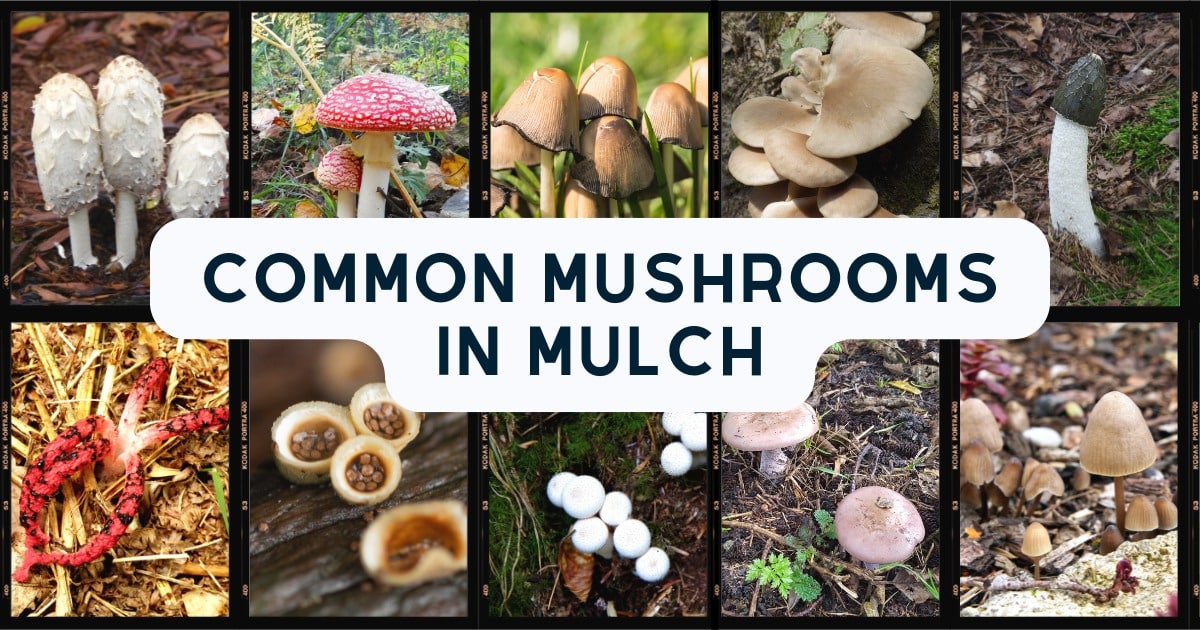
Jump to:
Are Mushrooms in Mulch Bad?
The short answer is that it depends. The long answer is a little more complicated and depends entirely on the mushroom species. Overall, mushrooms aren’t usually bad for the mulch or your yard; in fact, they can be quite beneficial. However, if they’re poisonous, they can pose problems for young children and pets who might eat them. The only way to know if a specific mushroom is problematic or not is to identify it.
While many gardeners focus on removing mushrooms, it’s important to recognize the beneficial role fungi play in garden ecosystems. Fungi are essential for decomposition, breaking down organic matter, and returning nutrients to the soil. They form symbiotic relationships with plants, effectively increasing the surface area of their root mass and helping them absorb water and nutrients more efficiently.
If mushrooms aren’t causing harm to your plants or posing a safety risk, consider embracing them as part of your garden’s biodiversity. You can even get fanciful or fun by adding decorative elements like gnomes or fairies to go along with the natural mushrooms.

The presence of mushrooms in your mulch is a positive sign of a healthy, biodiverse ecosystem:
- Soil Health Indicator: Mushroom growth in soil and mulch beds is a sign of rich organic matter and healthy soil. Much like the presence of earthworms, mushrooms indicate a thriving soil ecosystem.
- Ecosystem Support: The fungi that produce mushrooms support a wide range of organisms in the soil food web, contributing to overall biodiversity.
- Plant Health: Plants with mycelium growing through their organic matter tend to be healthier and more resistant to pests.
Instead of removing mushrooms, consider them a sign of a healthy garden ecosystem working in harmony with your plants.

Types of Mulch Fungi
Mulch fungi play a crucial role in garden ecosystems, breaking down organic matter and releasing nutrients back into the soil. Based on their interactions with plants and organic matter, these fungi can be categorized into three main types: saprophytic fungi, mycorrhizal fungi, and parasitic fungi. Most mushrooms in mulch are saprotrophic—they are there to break down the mulch and access the nutrients like it’s a buffet.
Saprophytic Fungi
Saprophytic fungi are nature’s recyclers, decomposing plant materials such as wood mulch and leaves. These microorganisms obtain their nutrients from decomposing organic materials and are not pathogenic, meaning they do not cause plant diseases. Saprophytes grow freely in the soil, deriving carbohydrates by degrading litter.
These fungi often become visible after prolonged periods of rain. They produce fruiting bodies that emerge from the mulch. Saprophytic fungi are essential for nutrient cycling, as they break down complex organic compounds into simpler forms that other organisms can use.
Mycorrhizal Fungi
Mycorrhizal fungi form a symbiotic relationship with plant and tree roots, creating a mutually beneficial partnership. These fungi are found in 90% of land plants and play a crucial role in plant nutrition and soil health.
Mycorrhizal fungi help plants absorb water and nutrients more efficiently, increasing the surface area of plant roots up to a thousand times. In exchange, plants provide the fungi with carbohydrates from photosynthesis. This symbiotic relationship enhances plant growth, improves drought resistance, and protects against soil-borne pathogens.
Parasitic Fungi
While less common in mulch, parasitic fungi can pose a threat to garden plants. One notable example is the honey fungus (Armillaria spp.), which causes white rot in trees, shrubs, and woody plants. Parasitic fungi like honey fungus can spread through spores and mycelial threads, attacking plant roots and causing extensive damage.
Unlike saprophytic and mycorrhizal fungi, parasitic fungi can harm living plants. They may spread underground through the soil, infecting healthy plants in their path. To protect the health of your garden, it’s important to monitor for signs of parasitic fungi and take appropriate action if detected.
Unfortunately, most of these parasitic fungi are tiny microorganisms that you can’t see with the naked eye until they become a problem. They aren’t the “traditional” mushrooms with a cap and stem.
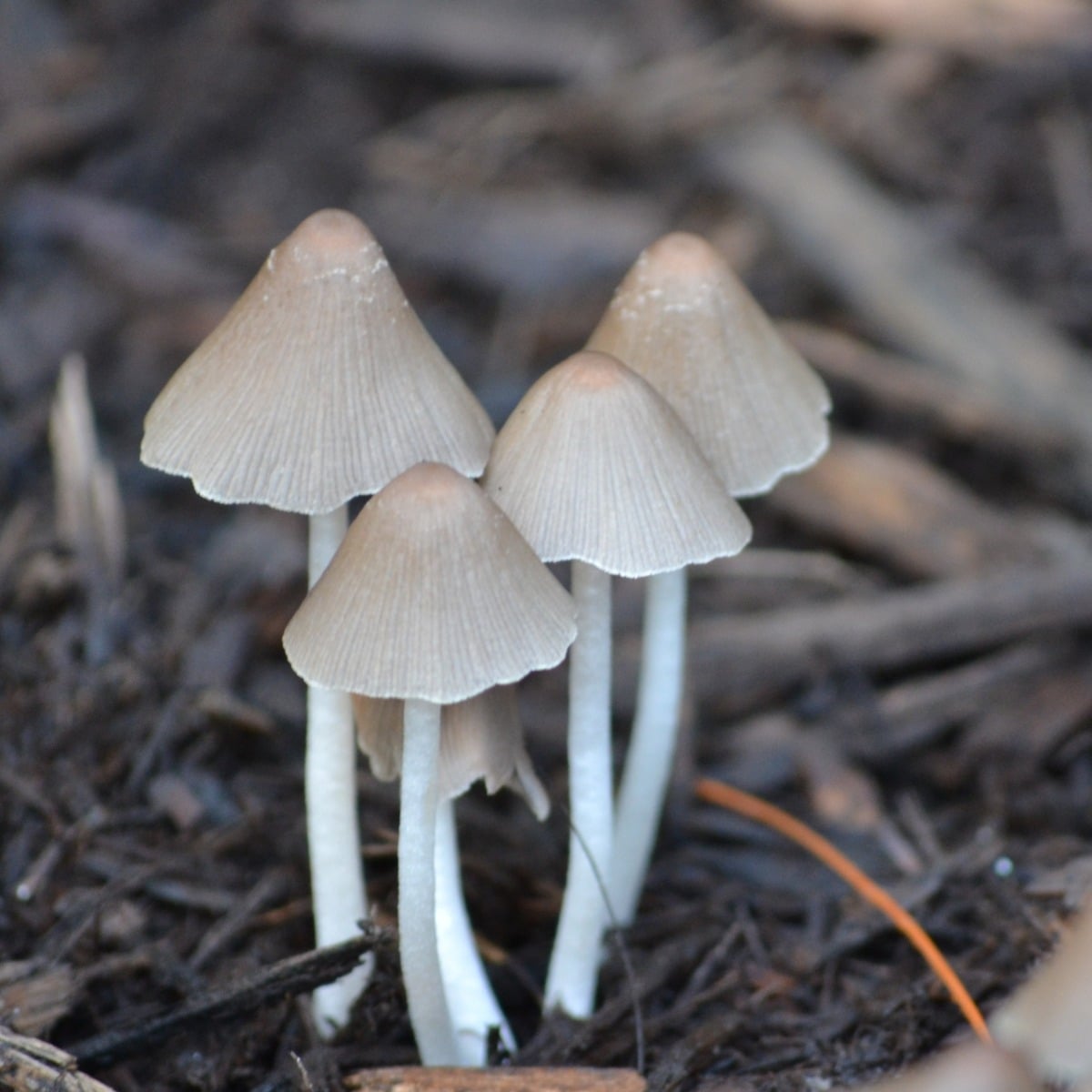
The 13 Most Common Mushrooms In Mulch
While all these fungi might initially seem alarming, they’re generally harmless and beneficial to your garden ecosystem. By understanding their role and appreciating their unique characteristics, gardeners can learn to coexist with these fascinating organisms.
Mycena [saprotrophic]
This is a large group of very small and often abundant mushrooms. They usually have a thin bell or cone-shaped cap and a thin stem, making the entire mushroom fragile. Besides their minute size and fragility, Mycena fungi vary widely in color—they can be white, tan, brown, or even blue.
Key Identification Features:
- Small, overall
- Thin cap flesh, thin stem
- Bell or cone-shaped cap
- Grows in groups or troops
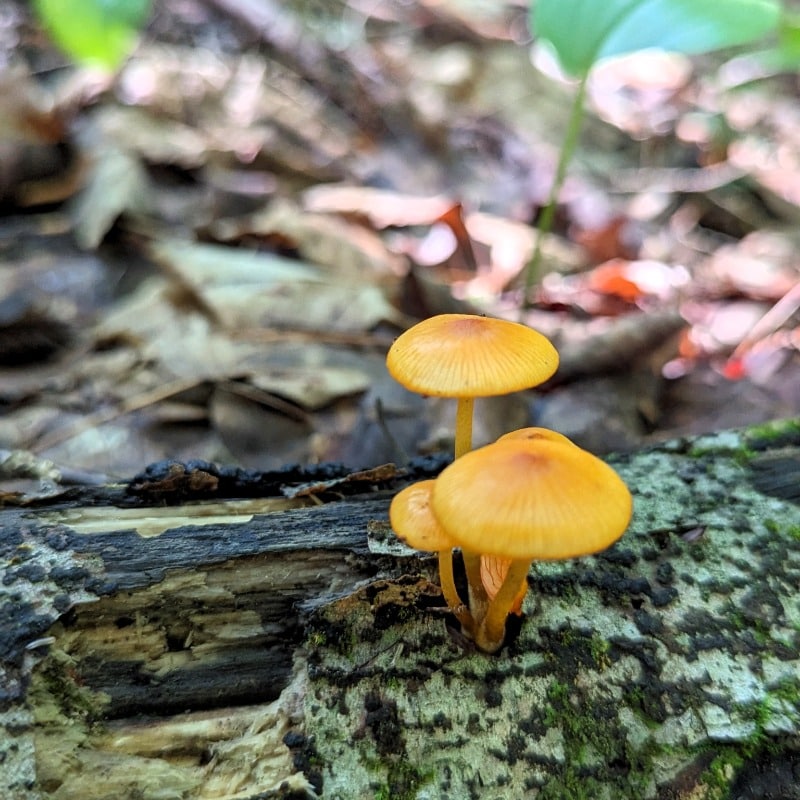
Field Mushroom, aka Meadow Mushroom [saprotrophic]
The field mushroom (Agaricus campestris) is a great find for any gardener. These mushrooms are edible but should be foraged carefully because they do have problematic lookalikes.
Field mushroom caps measure about 4 inches (10 cm) wide and are commonly found on lawns and growing in mulch. They’re recognizable by their domed caps, which start out smooth and white and gradually develop scales as they age. The stem is short and white, narrowing at the base and with a thin ring around the top.
One of the most distinctive features of the field mushroom is its gills. They start pink and gradually turn chocolate brown to deep black as the mushroom matures.
Key Identification Features:
- White to gray smooth cap
- White ring around the white stem
- Brown to black gills with maturity, pink when young
- Stem has a skirt around the top

Shaggy Mane [saprotrophic]
The shaggy mane (Coprinus comatus), also known as the Lawyer’s Wig, is another edible mushroom you might spot in your mulch. These mushrooms have caps that can grow up to 6 inches tall and are covered with pale, woolly scales that give them a shaggy appearance.
What makes the shaggy mane truly unique is its life cycle. As it matures, the mushroom’s gills begin to dissolve, turning into a black, ink-like substance. This process is actually a clever spore dispersal mechanism.
The shaggy mane is edible and quite tasty when young. It has one troublesome lookalike, but once you learn the main characteristics, it’s easy to tell them apart.
Key Identification Features:
- Tall with a long white stem
- White, elongated cap with white scales covering it
- Grows in scattered to dense groups

Inky Cap [saprotrophic]
The inky cap (Coprinopsis atramentaria) is a close relative of the shaggy mane but looks quite different. It has a small bell or cone-shaped cap and very thin flesh. It grows quickly and transforms from a regular-looking mushroom to a pile of black goo in a matter of days.
This species is edible but must be eaten the same day it is foraged because it will decompose very quickly. It also cannot be eaten with alcohol (2-3 days before or after drinking) because it will make you very ill. It’s not deadly, though.
Inky caps appear in massive groups in mulch beds, but they aren’t a problem and disappear almost as fast as they appeared. There are quite a few other inky cap species that look similar to this one and appear in mulch.
Key Identification Features:
- Small, thin caps and stem
- Appear in large groups
- Caps melt into black goo in a couple of days

Oyster Mushroom [saprotrophic]
Oyster mushrooms (Pleurotus ostreatus) are perhaps one of the most well-known and widely cultivated edible mushrooms. They’re characterized by their scalloped (oyster-shell-shaped) caps, which can be whitish-gray or tan in color.
These mushrooms usually appear in a shelf-like, overlapping formation on dying hardwood trees (oaks, maples, and dogwoods). Their gills are “decurrent”—this means they run down the stem partway.
Oyster mushrooms are known for their adaptability and can grow in various conditions. They will grow from dense mulch, gathering the necessary nutrients from the decomposing wood. So, don’t be surprised to see oyster mushrooms growing in the mulch, even though they are more common on trees.
Key Identification Features:
- White to grayish oyster-shell-shaped cap
- Whitish gills run partway down the stem
- Grows in overlapping groups
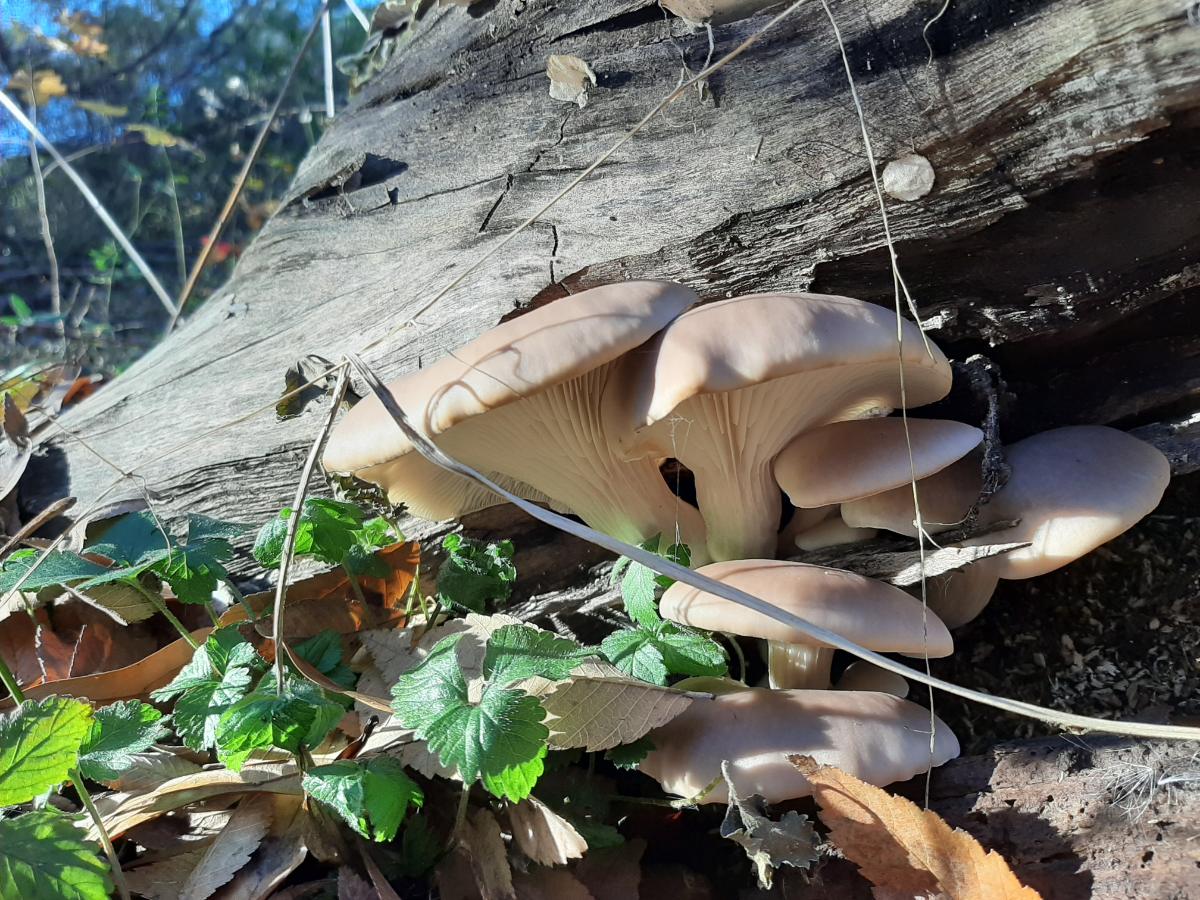
Fly Agaric [mycorrhizal]
The fly agaric (Amanita muscaria) is a striking mushroom that can grow as big as a dinner plate. It’s widely known for its distinctive appearance—a deep red cap with white patches. Fly agaric species may also have yellow caps with yellow patches, peach caps with yellowish patches, or red caps with yellow patches (warts).
These mushrooms are poisonous but usually not deadly. They contain muscimol, a psychoactive substance, and ibotenic acid, a neurotoxin. If you have young children or pets, you definitely want to remove this species.
Fly agarics generally grow in association with trees, forming a symbiotic relationship. Common tree species include oak, birch, cedar, fir, spruce, and pine.
The name “fly agaric” comes from its historical use as an insecticide. Pieces of the fungus were placed in a plate of milk to attract and kill flies. Interestingly, this mushroom is said to be able to “turn off fear” in humans. Vikings reportedly used it for this reason, and those who consumed it were called “berserkers.”
Key Identification Features:
- Brightly colored red, yellow, or peach cap
- Cap has whitish or yellowish scales or patches covering it
- White stem with a skirt at the top
- White gills

Yellow-Staining Mushroom [saprotrophic]
The yellow-staining mushroom (Agaricus xanthodermus) is responsible for many cases of mushroom poisoning around the world. While not deadly, it can cause severe gastric symptoms that can last up to 24 hours. It is in the same family as the Field mushroom (described further up), and some get that edible species confused with this one. Thankfully, the yellow stainer has two prime giveaways—it stains yellow, and it stinks!
The cap starts out white but usually turns brownish with age. The gills are white, then turn pink, and finally dark brown. The cap and stem stain yellow when handled, but it is especially noticeable at the base of the stem.
Key Identification Features:
- Whitish or brownish dome-shaped cap
- Pink or brown gills
- Cap and stem stain yellow when bruised
- White ring around the top of the stem.
- Smells like iodine – sickly sweet and very strong. It gets more intense with cooking.

Stinkhorns [saprotrophic]
Stinkhorns are among the most peculiar fungi you might find in your yard or garden. These mushrooms are known for their distinctive appearance and pungent odor. Stinkhorns often appear suddenly in mulch, lawns, and areas with bare soil – their lifecycle is very fast and short. They come in various shapes but are best known for their horn-like or phallic appearance. Some species even resemble octopuses with multiple appendages.
These fungi are not just visually striking; they also have a unique reproductive strategy. Stinkhorns produce a strong, offensive odor reminiscent of rotting flesh or dung. This smell attracts insects that help spread the fungal spores to new locations.
While stinkhorns might seem off-putting, they’re generally harmless and play a beneficial role in decomposing organic matter. If their presence becomes bothersome, you can simply pluck them from the ground and discard them.
Stinkhorns come in various shapes and colors:
- Some species resemble horns or have a phallic appearance.
- Others may have multiple appendages, giving them an octopus-like look.
- Colors range from white and beige to bright orange or red, sometimes with black accents.

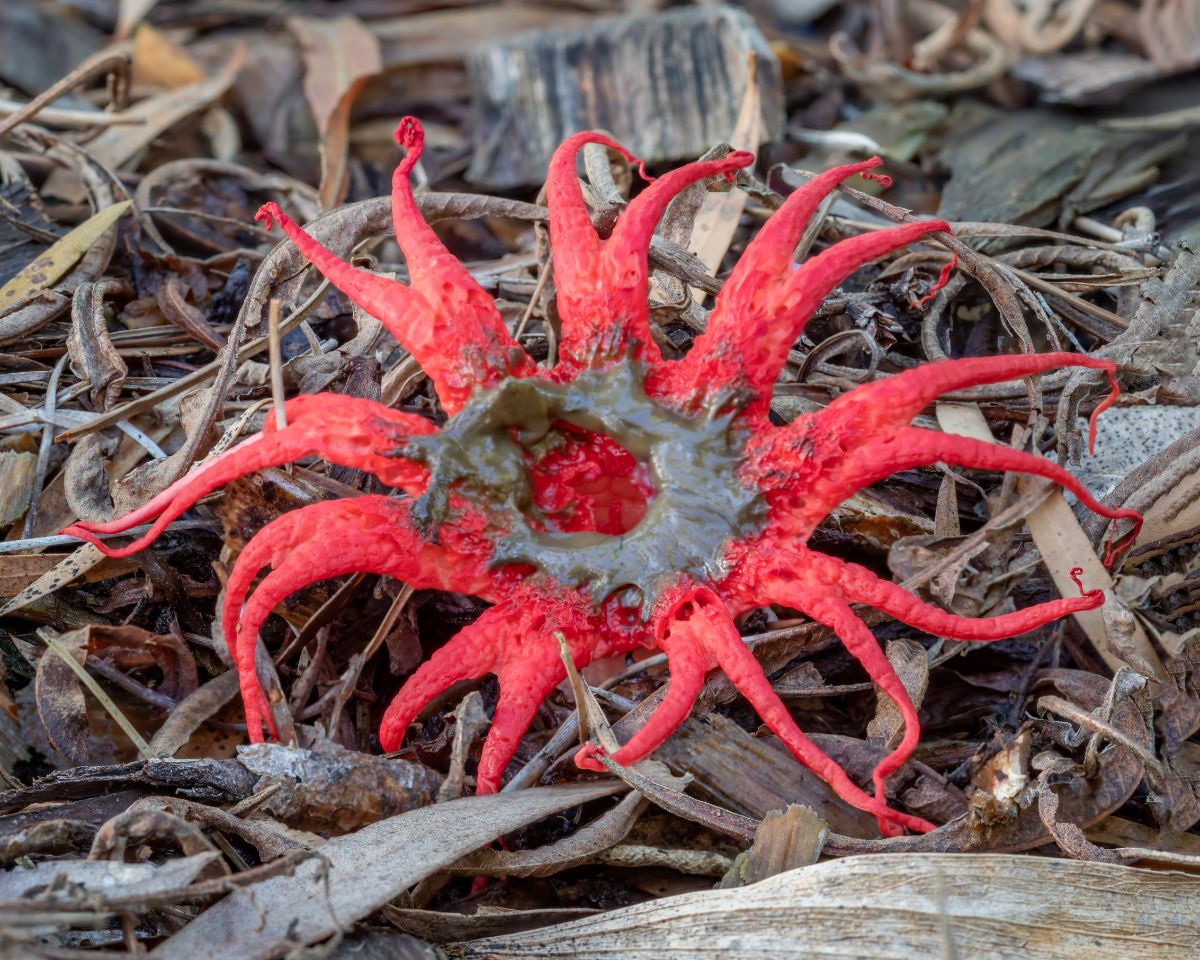
Puffballs [saprotrophic]
Puffballs are another group of unusual fungi that might appear in your mulch. These fungi get their name from their ability to release spores in a puff-like cloud when disturbed. Puffballs can vary in size and often grow in clusters.
The genus Lycoperdon, which includes many puffball species, gets its name from the Greek words for “wolf” and “fart,” referring to the puff of spores released when the fungus is disturbed.
One common species found in mulch is the pear-shaped puffball, aka the stump puffball. These puffballs prefer wood-based substrates and have no problem growing on decomposing mulch. Many other puffballs grow in grassy meadows, away from wood, but not this one.
While stomping on puffballs to release their spores might be tempting, it’s important to exercise caution. Inhaling a large number of spores can lead to respiratory issues, a condition known as lycoperdonosis. Also, the spreading of spores for sure means more puffballs the following year, which you may or may not want.
Puffballs play a vital role in breaking down mulch and other organic matter, contributing to soil health and plant nutrition. Rather than trying to eliminate them, gardeners are encouraged to appreciate their ecological function.
Key Identification Features:
- They often grow in clusters on wood mulch.
- The fruiting bodies are typically pear-shaped and soft.
- When young, the interior is white and fluffy like a marshmallow. With age, it disintegrates into powdery black spores.

Bird’s Nest Fungi [saprotrophic]
Perhaps the most whimsical mulch mushrooms are bird’s nest fungi. These tiny organisms resemble miniature bird’s nests, complete with “eggs” inside. The cup-shaped fruiting bodies of bird’s nest fungi are typically about ¼ inches (0.5 cm) in diameter. You really have to be paying attention to see them; they’re an enjoyable and cute discovery.
Bird’s nest fungi have a fascinating dispersal mechanism. When raindrops or irrigation water fall into the cup-shaped fruiting bodies, they splash out the “eggs” (called peridioles). These peridioles can be ejected up to 3 to 4 feet (1 m) away, helping the fungi spread to new areas.
These fungi are particularly helpful in breaking down large chunks of bark mulch into smaller pieces that can more easily enrich the soil.
Key Identification Features:
- Cup-shaped fruiting bodies that are about ¼ inch (0.5 cm) in diameter – the size of a fingernail or smaller
- “Eggs” (peridioles) inside each “nest” that contain millions of fungal spores.


Blewit [saprotrophic]
This edible species usually grows in the woods but also likes mulch beds and compost heaps. When young, the distinctive violet caps give them away, but this color soon fades to a dull tan and is often bypassed as boring. The blewit does have some troublesome lookalikes, so be careful when foraging this species. This is one that you will always want to do a spore print to verify what you’ve found.
Blewit mushrooms are a late season mushroom, showing up in late summer or fall. In warmer climates, they appear in winter.
Key Identification Features:
- Violet or lilac cap when young (turns dull brown with maturity)
- Smells like orange juice (fruity)
- Pinkish spore print

White Lepiotoid [saprotrophic]
This all-white Lepiotoid mushroom (Leucocoprinus cepistipes) loves wood chips and mulch beds. The cap is white with a brownish center, thin, and covered in a fine white powder. The stem is also white and has a ring around the top. Some people call this the “Rest Area Mushroom” because it so frequently appears in woodchips at heavily landscaped rest stops around the country.
This species is edible, but it doesn’t taste that good and is rarely foraged.
Key Identification Features:
- White cap with brownish center
- Cap covered in whitish powder
- White stem with a ring
- Bulbous stem base
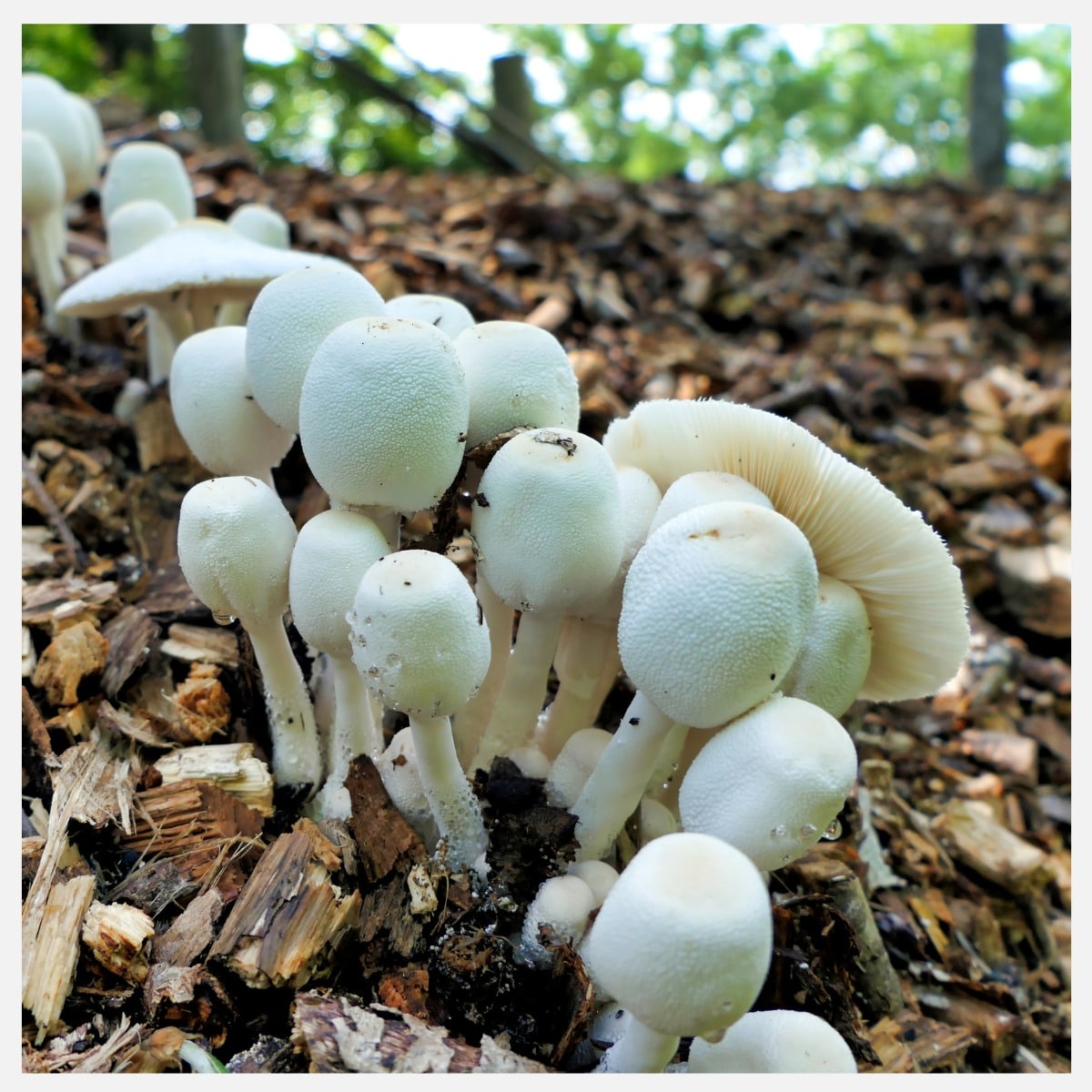
Yellow PlantPot Dapperling [saprotrophic]
The yellow plantpot dapperling, also known as the flowerpot parasol (Leucocoprinus birnbaumii), freaks out a lot of people. It usually appears quite suddenly in potted plants, and its bright yellow coloring is extremely dramatic. This species is related to the white lepiotoid (described above), but this one is toxic and should never be eaten. It’s not deadly, but it will make you sick.
This species is more known for appearing in potted plants, but it may also appear in landscaped and mulched areas.
Key Identification Features:
- Bright yellow with scales on the cap
- Yellow stem with a ring around the top
- Bulbous stem base
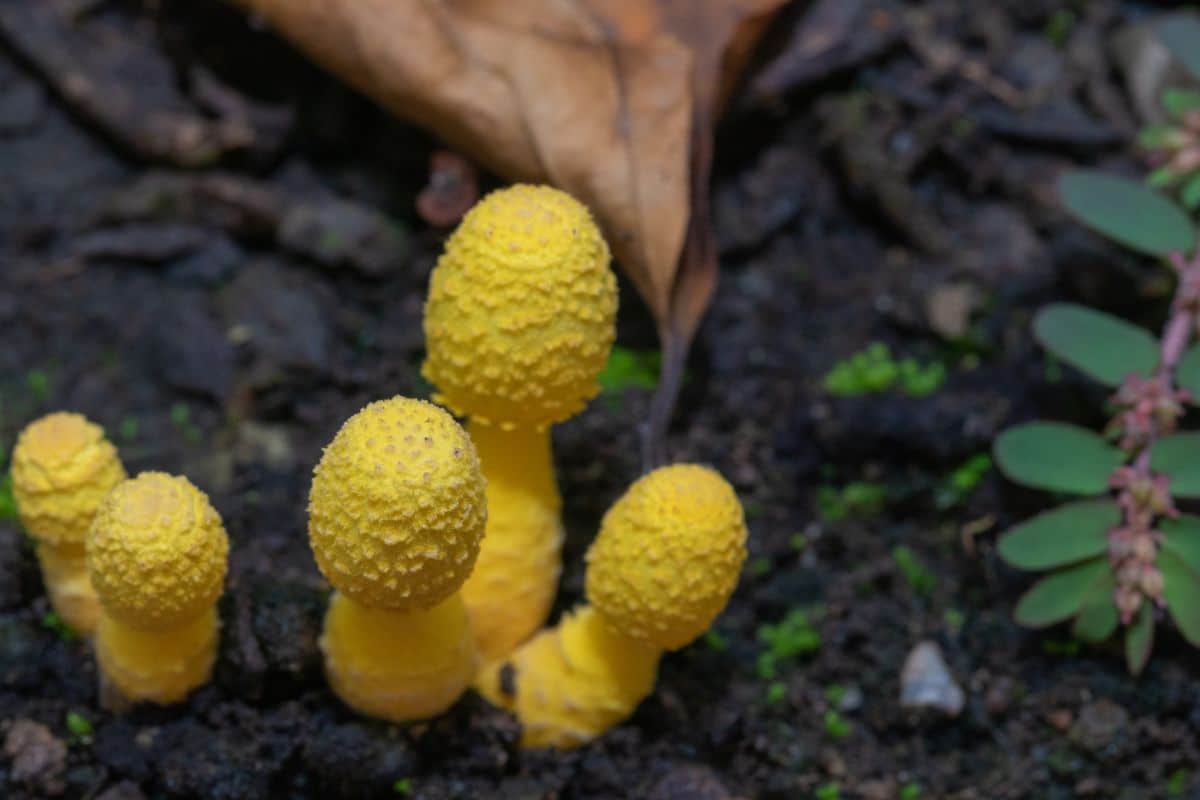
Slime Molds (Not Actually Fungi)
While not true fungi, these organisms often appear in mulch as bright yellow or orange foam-like growths, sometimes called “dog vomit slime mold” due to their appearance. However, although they’re not actually mushrooms, they often behave similarly. Most slime molds are decomposers – saprotrophic species. Some are parasitic, though, too.
Slime molds love shady, moist areas where there is decomposing wood, and mulched areas are their perfect habitat. While most people do not enjoy the look of slime molds in the mulch, these organisms don’t cause any harm. Like fungi, they help to break down organic material.

Benefits of Mulch Mushrooms
Mushrooms growing in mulch are often seen as a nuisance, but they actually provide numerous benefits to gardens and landscapes. These fungi play a crucial role in maintaining soil health and supporting plant growth.
Mushrooms are nature’s recyclers. They break down complex organic compounds, proteins, and carbohydrates into simpler forms that other organisms can use. This process is essential for nutrient cycling in the soil. The fungi that produce mushrooms live in the soil year-round as mycelium, a network of thread-like filaments called hyphae. These hyphae attach to plant roots and reach far into the soil, increasing the surface area of plant roots up to a thousand times.
Mushrooms and their underlying mycelium also contribute significantly to soil health:
Mycorrhizal filaments produce organic compounds that glue soils together, improving their structure and porosity. This enhanced soil structure promotes better root growth and water retention.
The extensive network of hyphae helps plants access water more efficiently, increasing their drought resistance. Mycorrhizae in the soil suppress soil-borne pathogens and protect plants from root diseases. This natural defense mechanism can reduce the need for chemical interventions.
Mushrooms accelerate the breakdown of organic matter in mulch, rapidly building soil and increasing the availability of nutrients.
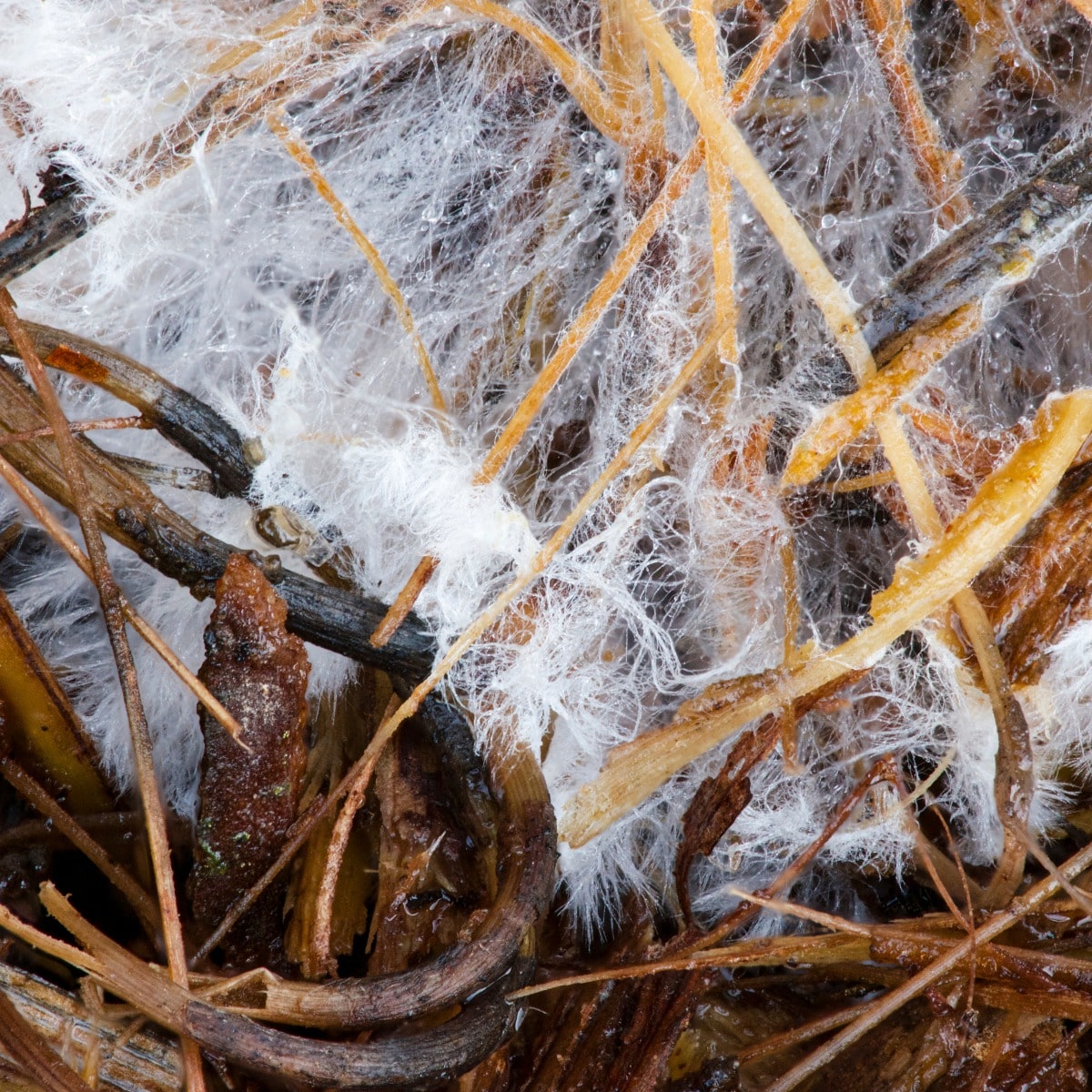
Managing Mushrooms in Garden Mulch
Removal Techniques
The easiest and quickest removal method is plucking them out of the ground by hand. You can wear gloves if they make you more comfortable, although it isn’t necessary. Toxins are not transmitted through touch – even the most toxic mushrooms must be eaten to be poisonous.
Another effective method is to use a rake or shovel to remove existing mushrooms and dispose of them away from the garden. Vinegar can be an effective fungicide for those seeking a more natural approach. Mix equal parts water and vinegar, then spray the solution directly on the mushrooms.
It’s important to understand, though, that this is only removing them temporarily. You are getting rid of or killing the fruiting bodies. It does not kill the mycelium underground, and the mushrooms will reappear, usually the following year but sometimes in the same year.
Prevention Methods
Preventing mushroom growth in mulch involves managing moisture levels and creating an environment less conducive to fungal growth. However, you must keep in mind that you’re not just dealing with the fungal element you see above the soil line. The life force of the mushroom is below ground in the mycorrhiza. And removing that is virtually impossible. It’s like trying to remove every single root shoot from a massive tree. You may get most of it, but it’s unlikely you’ll remove it all.
Since total extermination is pretty impossible, you’ll need to assess whether it’s worth the effort. Are the mushrooms really causing harm to the garden or yard, or are they just unsightly? Another thing to keep in mind is that most fungi have short above-ground lifespans. The majority that show up won’t last longer than a week, so if you wait a little bit, the problem disappears, at least for the moment.
- Improve drainage: Avoid circumstances where water sits on the mulch for extended periods.
- Reduce shade: Trim back or thin out branches on nearby trees and shrubs to allow more sunlight to reach the mulch.
- Rake regularly: Aerate the mulch by raking it regularly. This encourages drying out and disrupts the life cycle of potential fungal growth.
- Choose the right mulch: Use well-draining mulch with good air circulation, such as cedar chips or shredded bark.
- Maintain lawn hygiene: Keep the lawn and garden free of fallen leaves and other debris that can provide an ideal environment for mushrooms.
Common Questions About Mushrooms In Mulch
What kind of mushrooms typically grow in mulch?
There is not just one type. Many varied and interesting mushrooms appear in mulch. It is a prime habitat for a wide host of species.
Is it necessary to remove mushrooms from mulch?
No. You can remove them if you want, but that won’t necessarily prevent them from showing up later or the following year. Removing them does prevent spore dispersal, but the fungi mycorrhizae still exist beneath the ground.









Jeff says
I found large white mushroom in my garden. It is about5-6 inches wide. Looks like a breast with nipple. And is grayish underneath.
Jenny says
Please submit id requests to our facebook group. Make sure to read all the rules so all the necessary info is included and we can do an ID. Thanks! https://www.facebook.com/groups/340690111324762